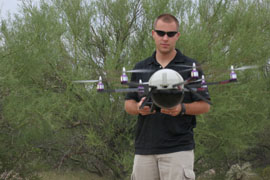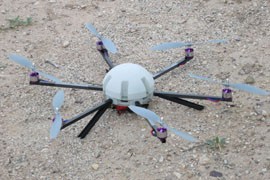Cronkite News has moved to a new home at cronkitenews.azpbs.org. Use this site to search archives from 2011 to May 2015. You can search the new site for current stories.
Arizona poised for boom in drone businesses, drone-related concerns
Editor’s Note: First of three in a series.
WASHINGTON – After the high-profile shooting of Border Patrol Agent Brian Terry in 2010, Scott Rollefstad felt he had to do something to help keep other agents safe.
So the Tucson resident headed to his garage and, after several months of tinkering, emerged with a backpack-sized surveillance drone. While Border Patrol already has military-scale drones on the border, Rollefstad said his 6-by-18-inch prototype can launch in minutes and be used for close-in surveillance, giving agents another set of eyes in the sky.
“There’s just no need for this type of blind, bumbling around in the bush, in our desert,” he said of agents on the ground.
Rollefstad hopes to some day sell his drone to police agencies and others to help save lives. But he also knows that not everyone sees drones the way he does.
“The minute someone hears ‘drones,’ they think of the Afghan killing machines,” he said.
That perception of drones as flying spy cameras and killing machines has raised concerns of privacy advocates, led to a flood of state and federal legislation and started the process of regulation by the Federal Aviation Administration.
Congress and 39 states, including Arizona, have considered measures to limit the use of unmanned aerial vehicles, or UAVs. Three states – Florida, Virginia and Idaho – have already passed regulations.
It comes as both government and industry analysts predict a surge in drones in U.S. skies, with smaller, cheaper machines opening new commercial and civil uses for drones that have mostly been in military use so far.
The FAA is scheduled to develop new regulations for the commercial use of drones – largely prohibited now – by 2015. While a handful of law-enforcement agencies already use UAVs for search-and-rescue and crime scene photos, the FAA estimates that there will be 30,000 commercial drones operating by 2030.
That concerns people like Joe Hall, a spokesman for the Center for Democracy and Technology. When anyone can attach a visual or thermal-imaging camera and launch a hobby drone they can buy online, the opportunity for invasion of privacy is great, he said.
“Should people have to build bubbles around their property?” Hall asks.
Because they can be small and hard to identify from the ground, Hall thinks the FAA should require that commercial drones be registered. He also thinks they should be required to emit a signal, identifying the operator and his purpose, that people could pick up on their personal computers and phones so they are aware of the drones around them.
“We’re not anti-drone, we just want to see them used responsibly,” he said.
Arizona Rep. Tom Forese, R-Gilbert, said any law needs balance and commonsense to protect private citizens, while encouraging a fledgling drone industry that could add thousands of jobs to the state’s already robust aerospace and defense industries.
“This is our legacy, and opportunities are rightfully Arizonan,” he said of the prospect of new jobs in a new commercial drone industry.
Forese introduced a bill this year calling for a committee to study “the economic development, safety and privacy concerns and potential applications” of UAVs in the state. That committee is to report back to the legislature by the end of this year.
Analysts say Arizona, which is one of 37 states vying for one of six UAV test ranges the federal government will designate, is poised to capitalize on the expected growth in jobs, once the FAA opens the skies to commercial drones.
“I think Arizona should have a very robust marketplace,” said Darryl Jenkins, of the Association for Unmanned Vehicle Systems International.
In addition to entrepreneurs like Rollefstad, Jenkins said large defense firms can also be expected to get into the civilian drone market. Once drones are cleared for commercial use, Jenkins predicts that precision agricultural uses will dominate the market, with public-safety applications in second place.
Some law-enforcement agencies are already taking advantage of the technology.
Benjamin Miller, who manages the drone program for the Mesa, Colo., County Sheriff’s Office, said the office started flying UAVs because of the cost: Drones are about $25 an hour to operate, compared with $250 to $1,000 per hour for a traditional aircraft.
Miller flies both a backpack-sized helicopter and a small airplane that can fit the trunk of a car. They have been used at fires, to find missing people and, recently, to survey a local landfill, which he said saved Mesa County almost $10,000.
Miller had the idea to start using drones five years ago and said that in four years his office has flown more than 40 missions. Miller, who said Mesa County residents have supported the drones, told a U.S. Senate committee recently that the potential for invasion of privacy did not start with the development of UAVs.
“Any tool can be abused. This sad reality is not unique to law enforcement nor did it begin with unmanned aircraft,” Miller told the Senate Judiciary Committee in March.
Miller, whose office is one of 22 local law-enforcement agencies with approval to operate drones in the United States, testified that under current FAA rules, officers can only use drones within sight for short, specific missions, which prevents infringement on privacy. He also said the International Association of Chiefs of Police have issued guidelines to encourage responsible use of drones.
“In this conversation it’s very important to focus on the information,” he said. “It doesn’t matter how we collect it. It’s what we do with it.”
Rollefstad hopes that his Cylone 6 prototype will some day be one of those tools in the police toolkit.
The six-propeller micro-drone can fly straight up to a predetermined height and zip away with a click on the map on a standard laptop. He said its design allows it to stay airborne longer by using wind currents to soar when possible.
“A lot of the companies I have worked for in the past have spent millions on systems that are difficult to use,” he said
Rollefstad and his team have started a business, Cyclone Autonomous Design Group and are looking for grants to get into the next phase of development. They also hope to be part of any discussion on regulation of the fledgling industry.
“I’m a problem solver, I want to come to an agreement,” he said.










